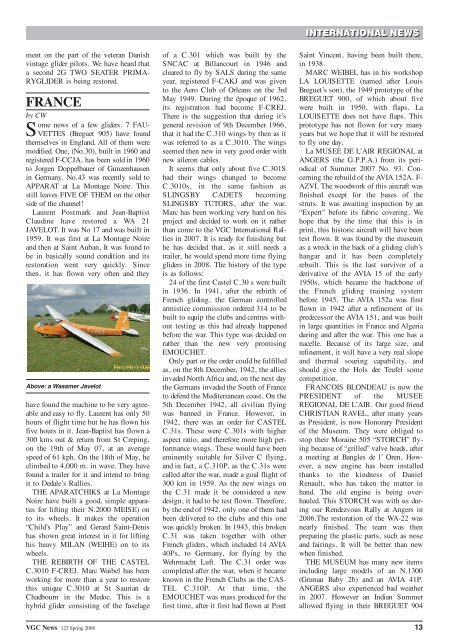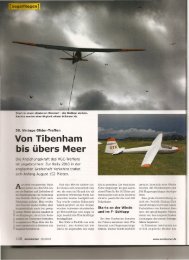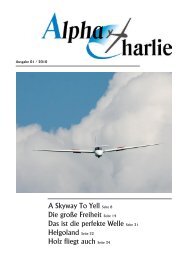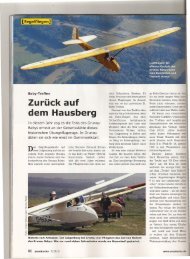Download - Vintage Glider Club
Download - Vintage Glider Club
Download - Vintage Glider Club
Create successful ePaper yourself
Turn your PDF publications into a flip-book with our unique Google optimized e-Paper software.
ment on the part of the veteran Danish<br />
vintage glider pilots. We have heard that<br />
a second 2G TWO SEATER PRIMA-<br />
RYGLIDER is being restored.<br />
FRANCE<br />
by CW<br />
Some news of a few gliders. 7 FAU-<br />
VETTES (Breguet 905) have found<br />
themselves in England. All of them were<br />
modified. One, (No.30), built in 1960 and<br />
registered F-CCJA, has been sold in 1960<br />
to Jorgen Doppelbauer of Gunzenhausen<br />
in Germany. No.43 was recently sold to<br />
APPARAT at La Montage Noire. This<br />
still leaves FIVE OF THEM on the other<br />
side of the channel!<br />
Laurent Postmark and Jean-Baptist<br />
Claudine have restored a WA 21<br />
JAVELOT. It was No 17 and was built in<br />
1959. It was first at La Montage Noire<br />
and then at Saint Auban, It was found to<br />
be in basically sound condition and its<br />
restoration went very quickly. Since<br />
then, it has flown very often and they<br />
Above: a Wassmer Javelot<br />
have found the machine to be very agreeable<br />
and easy to fly. Laurent has only 50<br />
hours of flight time but he has flown his<br />
five hours in it. Jean-Baptist has flown a<br />
300 kms out & return from St Creping,<br />
on the 19th of May 07, at an average<br />
speed of 61 kph. On the 18th of May, he<br />
climbed to 4,000 m. in wave. They have<br />
found a trailer for it and intend to bring<br />
it to Dedale’s Rallies.<br />
THE APARATCHIKS at La Montage<br />
Noire have built a good, simple apparatus<br />
for lifting their N.2000 MEISE) on<br />
to its wheels. It makes the operation<br />
“Child’s Play” and Gerard Saint-Denis<br />
has shown great interest in it for lifting<br />
his heavy MILAN (WEIHE) on to its<br />
wheels.<br />
THE REBIRTH OF THE CASTEL<br />
C.3010 F-CREJ. Marc Waibel has been<br />
working for more than a year to restore<br />
this unique C.3010 at St Saurian de<br />
Chadbourn in the Medoc. This is a<br />
hybrid glider consisting of the fuselage<br />
of a C.301 which was built by the<br />
SNCAC at Billancourt in 1946 and<br />
cleared to fly by SALS during the same<br />
year, registered F-CAKJ and was given<br />
to the Aero <strong>Club</strong> of Orleans on the 3rd<br />
May 1949. During the époque of 1962,<br />
its registration had become F-CREJ.<br />
There is the suggestion that during it’s<br />
general revision of 9th December 1966,<br />
that it had the C.310 wings by then as it<br />
was referred to as a C.3010. The wings<br />
seemed then new in very good order with<br />
new aileron cables.<br />
It seems that only about five C.301S<br />
had their wings changed to become<br />
C.3010s, in the same fashion as<br />
SLINGSBY CADETS becoming<br />
SLINGSBY TUTORS, after the war.<br />
Marc has been working very hard on his<br />
project and decided to work on it rather<br />
than come to the VGC International Rallies<br />
in 2007. It is ready for finishing but<br />
he has decided that, as it still needs a<br />
trailer, he would spend more time flying<br />
gliders in 2008. The history of the type<br />
is as follows:<br />
24 of the first Castel C.30 s were built<br />
in 1936. In 1941, after the rebirth of<br />
French gliding, the German controlled<br />
armistice commission ordered 314 to be<br />
built to equip the clubs and centres without<br />
testing as this had already happened<br />
before the war. This type was decided on<br />
rather than the new very promising<br />
EMOUCHET.<br />
Only part or the order could be fulfilled<br />
as, on the 8th December, 1942, the allies<br />
invaded North Africa and, on the next day<br />
the Germans invaded the South of France<br />
to defend the Mediterranean coast. On the<br />
5th December 1942, all civilian flying<br />
was banned in France. However, in<br />
1942, there was an order for CASTEL<br />
C.31s. These were C.301s with higher<br />
aspect ratio, and therefore more high performance<br />
wings. These would have been<br />
eminently suitable for Silver C flying,<br />
and in fact, a C.310P, as the C.31s were<br />
called after the war, made a goal flight of<br />
300 km in 1959. As the new wings on<br />
the C.31 made it be considered a new<br />
design, it had to be test flown. Therefore,<br />
by the end of 1942, only one of them had<br />
been delivered to the clubs and this one<br />
was quickly broken. In 1943, this broken<br />
C.31 was taken together with other<br />
French gliders, which included 14 AVIA<br />
40Ps, to Germany, for flying by the<br />
Wehrmacht Luft. The C.31 order was<br />
completed after the war, when it became<br />
known in the French <strong>Club</strong>s as the CAS-<br />
TEL C.310P. At that time, the<br />
EMOUCHET was mass produced for the<br />
first time, after it first had flown at Pont<br />
INTERNATIONAL NEWS<br />
Saint Vincent, having been built there,<br />
in 1938.<br />
MARC WEIBEL has in his workshop<br />
LA LOUISETTE (named after Louis<br />
Breguet’s son), the 1949 prototype of the<br />
BREGUET 900, of which about five<br />
were built in 1950, with flaps. La<br />
LOUISETTE does not have flaps. This<br />
prototype has not flown for very many<br />
years but we hope that it will be restored<br />
to fly one day.<br />
La MUSEE DE L’AIR REGIONAL at<br />
ANGERS (the G.P.P.A.) from its periodical<br />
of Summer 2007 No. 93. Concerning<br />
the rebuild of the AVIA 152A. F-<br />
AZVI. The woodwork of this aircraft was<br />
finished except for the bases of the<br />
struts. It was awaiting inspection by an<br />
“Expert” before its fabric covering. We<br />
hope that by the time that this is in<br />
print, this historic aircraft will have been<br />
test flown. It was found by the museum<br />
as a wreck in the back of a gliding club’s<br />
hangar and it has been completely<br />
rebuilt. This is the last survivor of a<br />
derivative of the AVIA 15 of the early<br />
1950s, which became the backbone of<br />
the French gliding training system<br />
before 1945. The AVIA 152a was first<br />
flown in 1942 after a refinement of its<br />
predecessor the AVIA 151, and was built<br />
in large quantities in France and Algeria<br />
during and after the war. This one has a<br />
nacelle. Because of its large size, and<br />
refinement, it will have a very real slope<br />
and thermal soaring capability, and<br />
should give the Hols der Teufel some<br />
competition.<br />
FRANCOIS BLONDEAU is now the<br />
PRESIDENT of the MUSEE<br />
REGIONAL DE L’AIR. Our good friend<br />
CHRISTIAN RAVEL, after many years<br />
as President, is now Honorary President<br />
of the Museum. They were obliged to<br />
stop their Moraine 505 “STORCH” flying<br />
because of “grilled” valve heads, after<br />
a meeting at Bangles de l’ Oren. However,<br />
a new engine has been installed<br />
thanks to the kindness of Daniel<br />
Renault, who has taken the matter in<br />
hand. The old engine is being overhauled.<br />
This STORCH was with us during<br />
our Rendezvous Rally at Angers in<br />
2006.The restoration of the WA-22 was<br />
nearly finished. The team was then<br />
preparing the plastic parts, such as nose<br />
and fairings. It will be better than new<br />
when finished.<br />
THE MUSEUM has many new items<br />
including large models of an N.1300<br />
(Grunau Baby 2b) and an AVIA 41P.<br />
ANGERS also experienced bad weather<br />
in 2007. However an Indian Summer<br />
allowed flying in their BREGUET 904<br />
VGC News 123 Spring 2008 13







